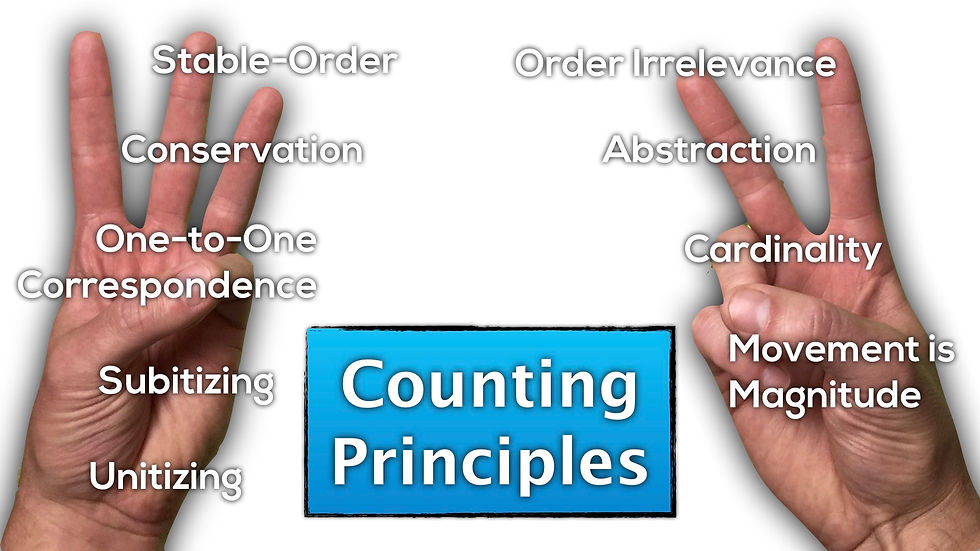Developing Number Sense in the Early Years
- Sean Cousins
- Jul 19, 2017
- 3 min read

As an elementary occasional educator, I have often experienced teaching a classroom or learning environment where some students demonstrate at least some struggle with number sense. I introduce a challenge or scenario consisting of a word problem featuring some numbers reflecting the curricula expectations to conduct operations (e.g., addition, subtraction, multiplication, and/or division) and resolve using some form of representation (e.g., number lines, charts, or equations) only to find out that several students finish early, some become animated and off-task, and some further asking questions about what and and how to proceed. What I have come to realize (and subsequently appreciate) is that these latter subgroups find, as evidenced through their demonstrations, counting, naming numbers, remembering numbers, and writing them down an ambiguous affair and therefore an activity too difficult at the present time to pursue or undertake. In reflection, some of these students with challenge may present behaviours associated with dyscalculia.
In any event, the proposed challenges or scenarios I leveraged to the classroom at the very least involve a complex array of conceptual and procedural know-how (i.e., number sense), all of which is related to the perceived social need (provincial mathematics curricula) of being able to manipulate numbers according to general (i.e., abstract, formal, or non-contextual data) rules and to do so embedded within a spectrum of meaning-making activities (e.g., descriptive, contextual, intuitive data). Linking these domains (e.g., formal with informal, non-contextual with contextual) lies, I believe, at the heart of effective teaching in early mathematics instruction.
Number sense is the ability to interpret numbers and to use them correctly and confidently (Ontario Ministry of Education, 2003, p. 227). Marion Small suggests examples of how an educator might come to initially understand the perceived competencies of students in their work with number sense through performance tasks, interviews or pencil-and-paper tests (The Learning Exchange, 2017). Such early and ongoing assessment interventions facilitate critical insight into what students excel at and struggle with, while these also inform how the teaching and learning process can dynamically unfold through effective differentiation for each student (See Ontario's Renewed Math Strategy, 2017). Research additionally points out that understanding the psycho-social developments of early mathematics learners and of the mathematics for early learning (e.g., Deborah Loewenberg Ball, 2005) has profound impacts on the ability to construct rich, engaging, early mathematics learning environments (Maximizing Student Mathematical Learning in the Early Years, 2011).
The remaining portion of this posting is a critical review of the work of Witzel, Ferguson, and Brown (2007) and, accordingly, it attempts to address how an elementary educator can interrelate the abstract and context-rich domains of learning to support the fusion of mathematical literacy in the Early Years, thereby minimizing the impacts of dyscalculia and similar other learning challenges associated with having poor number sense.
Witzel, Ferguson, and Brown (2007) outline three ways in which educators can facilitate marked or observable improvement in students' number sense.
1) Give students concrete experience with numbers along with the more abstract lessons.
Provide students with access to various everyday manipulatives or "loose materials" (Materials for Sparking Children's Curiosity and Play, 2012, p. 213) in each lesson or activity, thereby assisting with the children's fusion of immediate experience with abstract thinking (Refer to Paying Attention to Mathematics Education, 2012, Classroom Resources).
2) Teach the skills until they master them.
While modelling number sense through explicit instruction, provide students with multiple and engaging opportunities to problem solve. Through this pedagogical approach, students can feel confident that you have their best interests at play during the teaching of mathematics and are more inclined to pursue risk-taking activities (e.g., demonstrating learning in front of peers, linking classroom learning with personal life outside of the school environment). Recently, the use of "number talks," a strategy introduced by Shelly Perrish (Building Numerical Reasoning, 2014), is credited as a particularly effective approach to link instruction with the learning of numbers. An example of a session where number talks is used to develop numerical reasoning and strategy development is presented below.
3) Teach them to talk about math, write about math, and understand words relating to math. Have conversations with them about mathematics, using the new terms.
Situate the teaching of mathematical language (e.g., addition, sum, product, quotient, divisor, equals) with and through a number of different types of texts (e.g., fiction and non-fiction, maps, calendars, architectural sketches, newspaper graphs, statistics, graphic novels, digital medias). Using this context-rich environment of mathematical teaching and learning offers students with the ability to make critical and abundant connections among and within a number of texts and also between texts and their everyday lives.
For Kindergarten, Mary Jean Gallagher and Jim Grieve provide a seminar on how educators might re-imagine the interrelationships that can be forged among literacy and numeracy.
For subsequent grades, educators might wish to consult the Capacity Building Series Monograph "Literacy Blocks for Literacy and Numeracy (2009)"


Comments